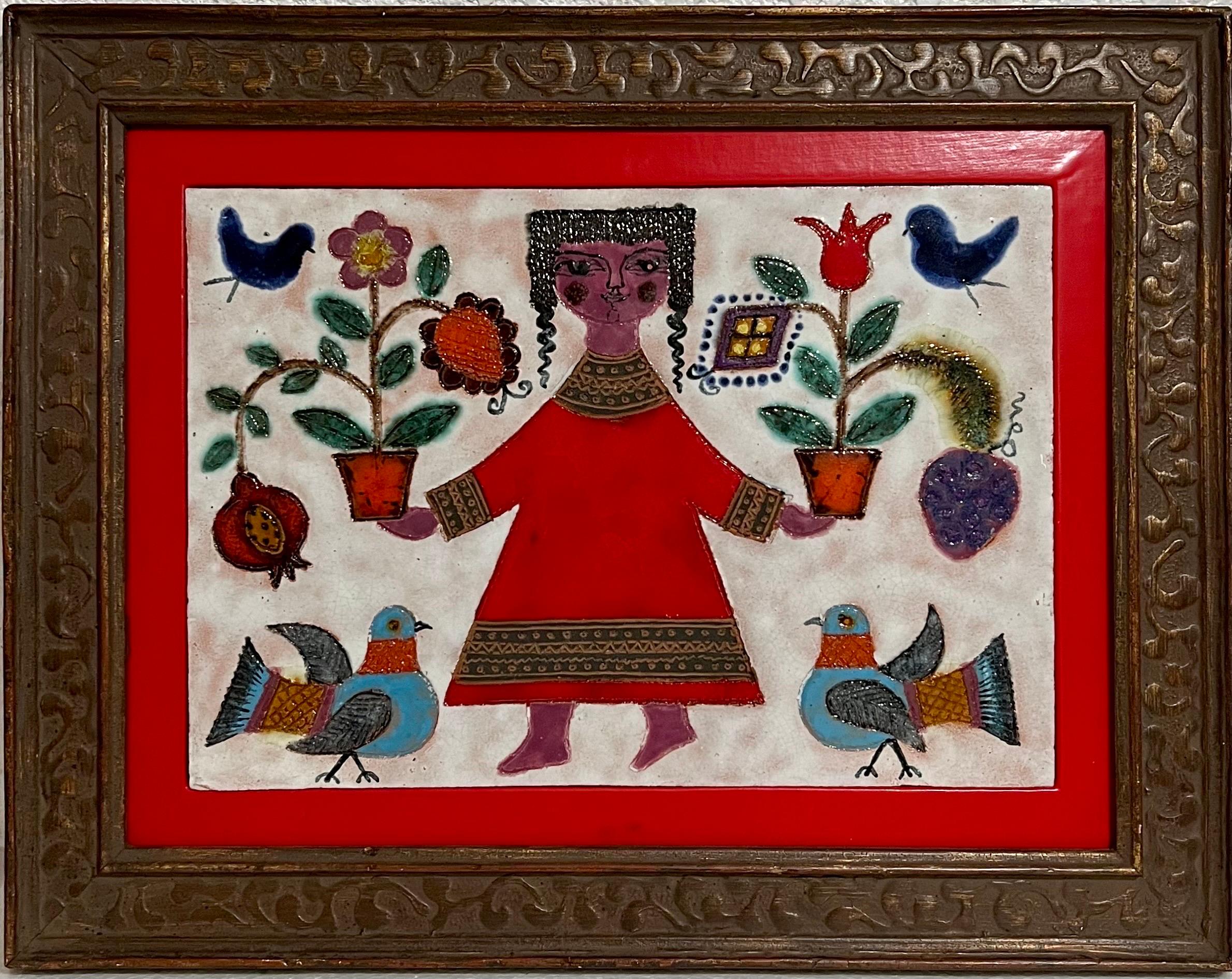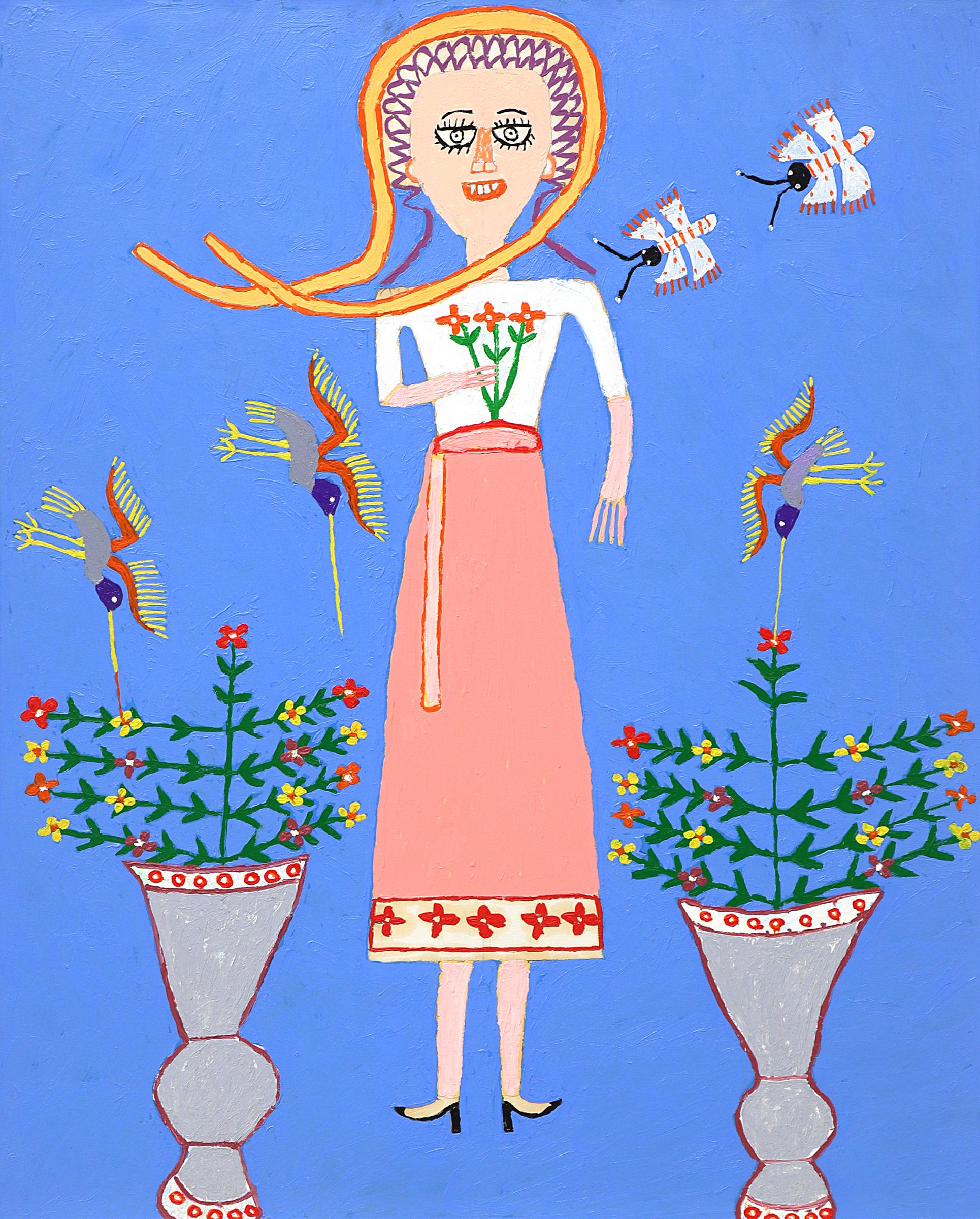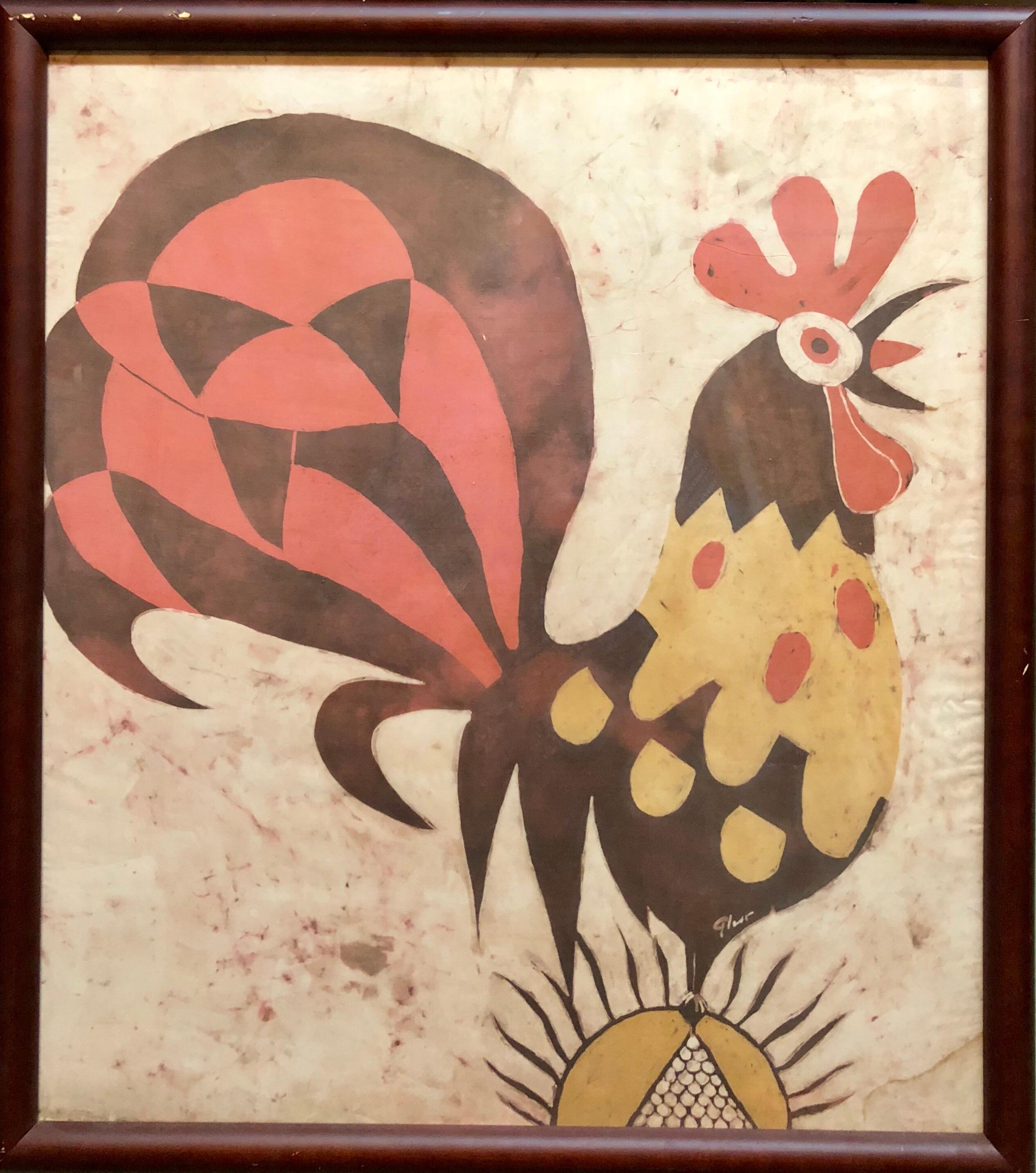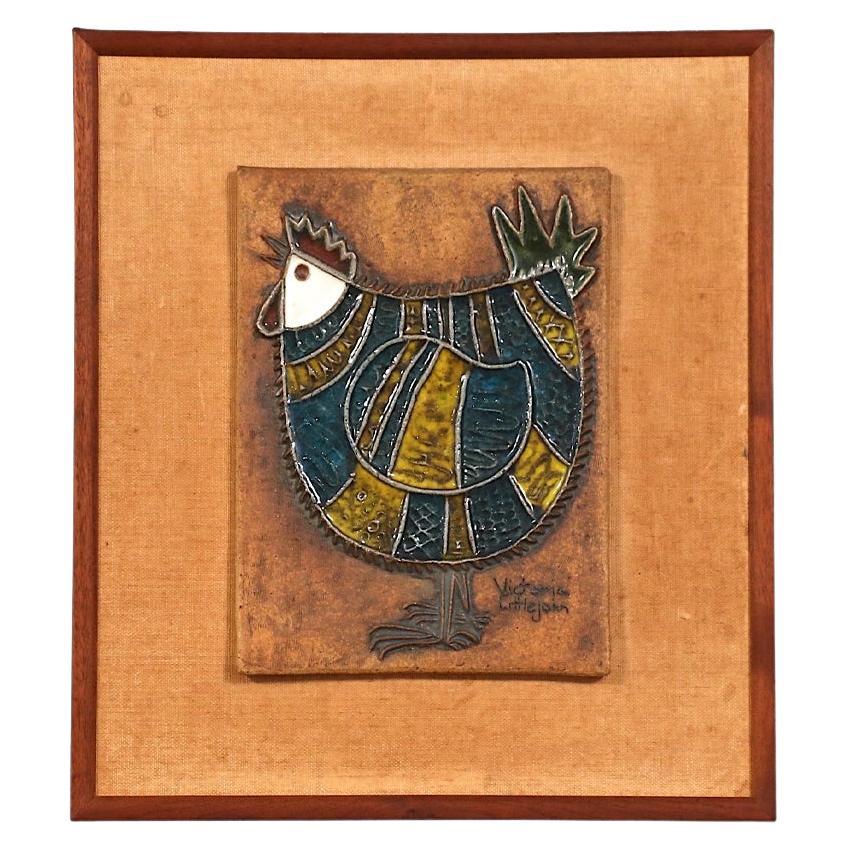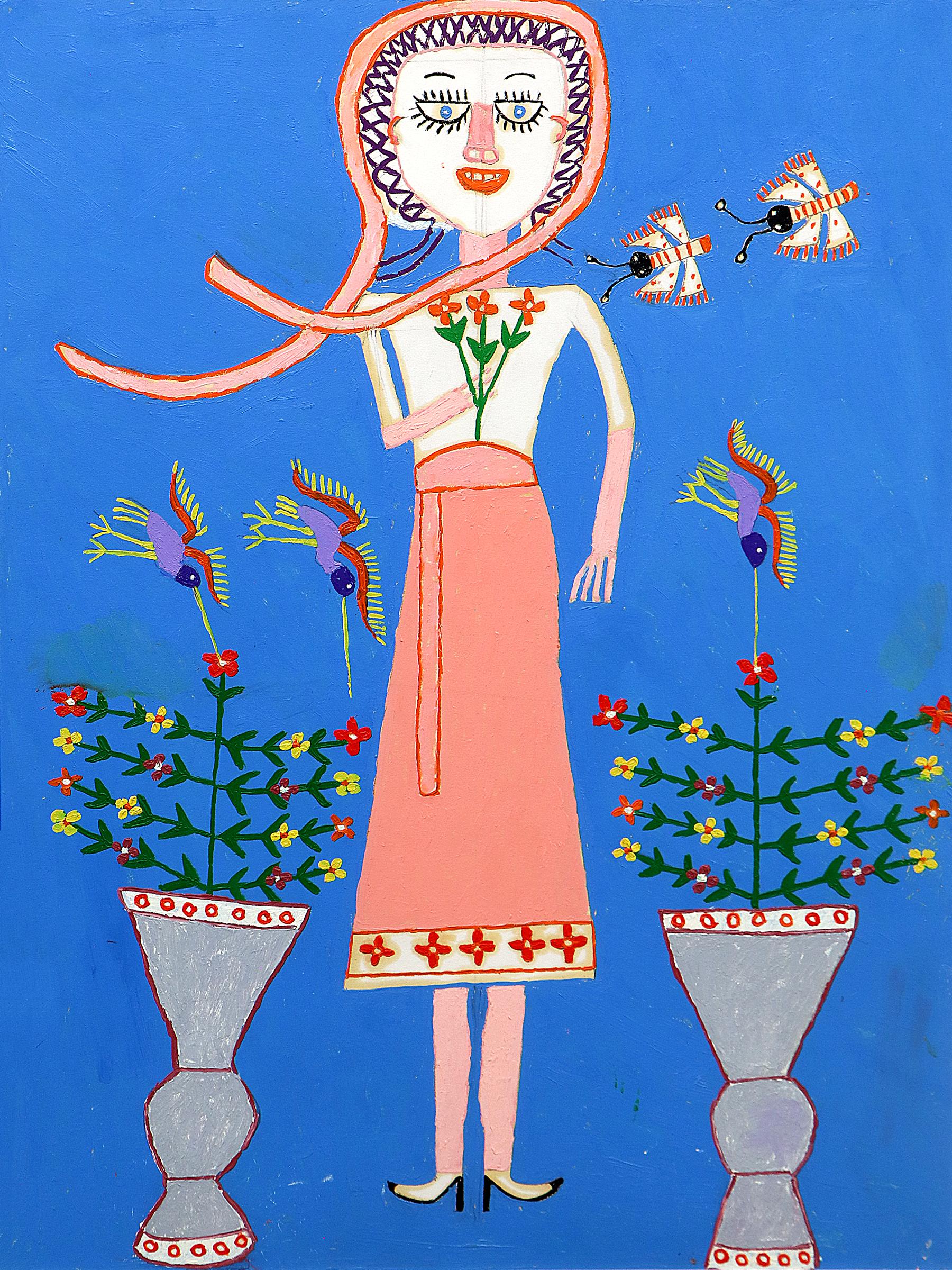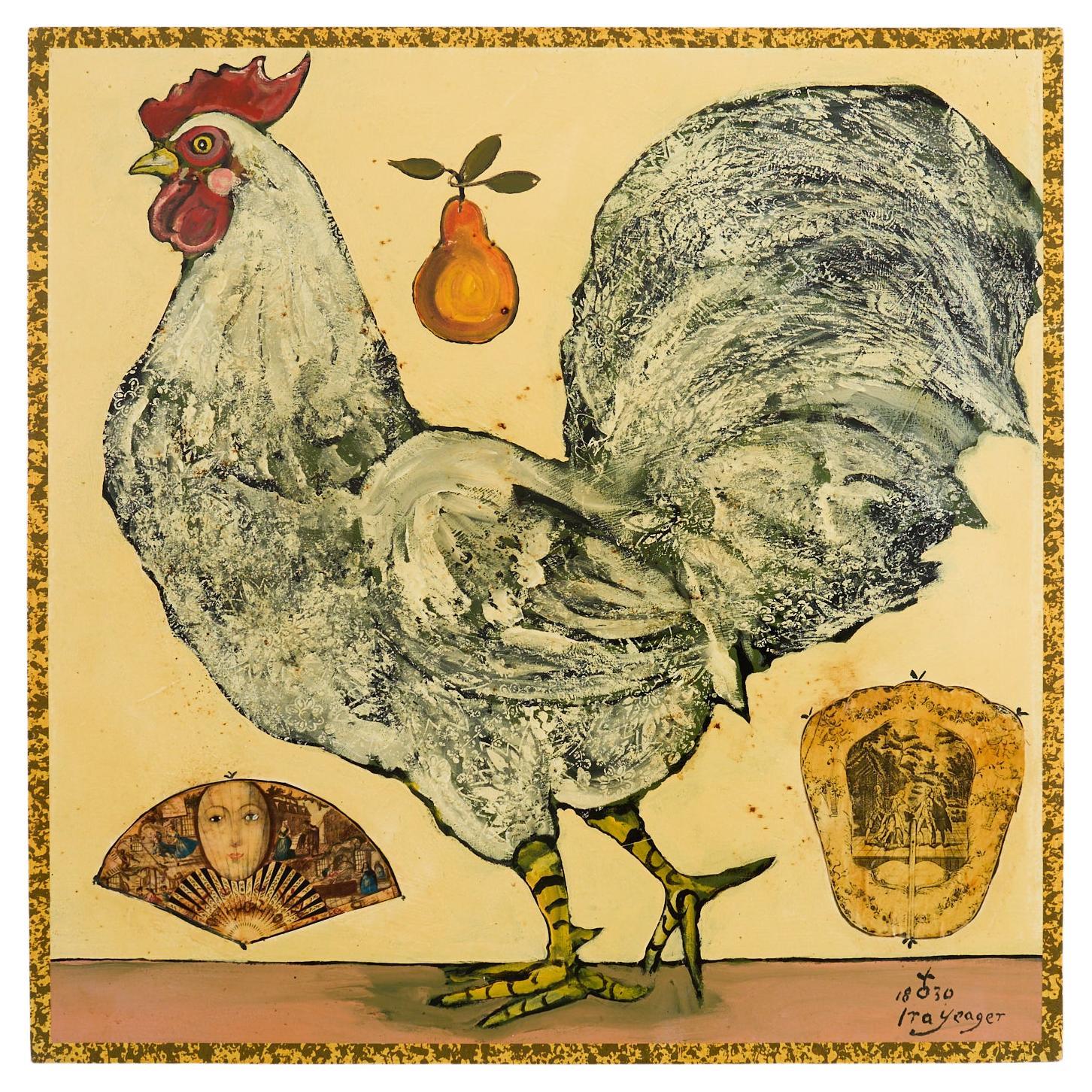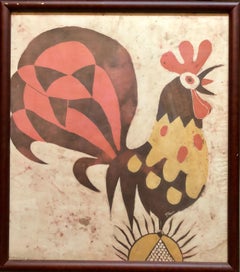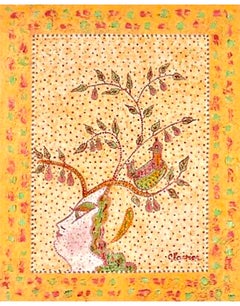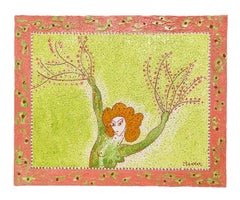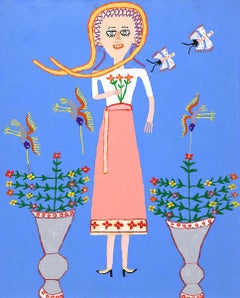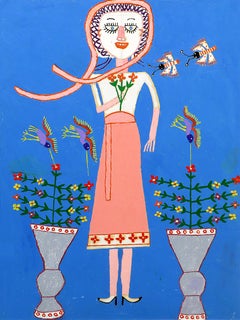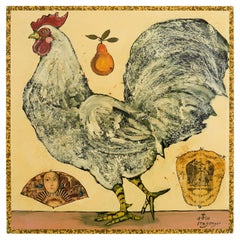Items Similar to Girl & Rooster Enamel Glazed Ceramic Plaque Israeli Artist Awret Naive Folk Art
Want more images or videos?
Request additional images or videos from the seller
1 of 11
Irene AwretGirl & Rooster Enamel Glazed Ceramic Plaque Israeli Artist Awret Naive Folk Art
$1,200
£910.53
€1,041.11
CA$1,676.07
A$1,863.57
CHF 973.05
MX$22,684.15
NOK 12,415.72
SEK 11,632.93
DKK 7,770.01
Shipping
Retrieving quote...The 1stDibs Promise:
Authenticity Guarantee,
Money-Back Guarantee,
24-Hour Cancellation
About the Item
This is a rare ceramic plaque painted with enamel glaze by famed Israeli German artist Irene Awret is signed Awret Safed on the verso. the actual glazed ceramic is 10X15 inches.
Irène Awret was born to a Jewish family in Berlin called Spicker, the youngest of three children. Her mother died in 1927, when Irène was six years old. In 1937 she was forced to stop high school, due to the Nazi race laws. Because she could not continue her regular studies, her father sent her to study drawing, painting and art restoration with a Jewish painter. Among his students were a large number of German Jews who knew they would have to leave Germany within a short time and would require a profession to enable them to support themselves.
When the situation grew worse, following the Kristallnacht (the first major attack on German and Austrian Jews in November 1938), her uncle decided to move to Belgium. In 1939 the situation became even worse - her father was fired from his job and the family were forced to leave their home. As a result, Awret's father tried to send her and her sister to Belgium, with the help of smugglers. The first smuggler proved to be a double agent and they were sent back from Aachen to Berlin. Two weeks later they made a second, successful, attempt to sneak across the border.
Awret worked for a Dutch Jewish family as a maid. As she had her room and board there, she was able to save enough money to study art part-time at Brussels' Académie Royal des Beaux-Arts. A few months later Awret's father joined her and her financial situation became easier. She left her job and studied full-time, helping support herself with restoration work when it was available and by painting portraits to order.
Later, Awret found a hiding place on a farm in Waterloo with a Jewish family who were connected with the underground. In January 1943 she had to return to Brussels, living with a false identity card which stated she was a married woman with two children. Awret succeeded in renting an attic without informing the police where she was - she told her landlady that she had been forced to flee her husband because he beat her. While there, she supported herself by restoring wooden sculptures.
A Jewish informer gave her up to the Gestapo, accompanying the two Gestapo men who arrested her. Awret was able to take a bag containing food and drawing materials. She was detained in the Gestapo cellars in Brussels where she drew. Because there was nothing there to draw, she sketched her own hand (view this work). Awret was interrogated in order to reveal the hiding place of her father who was still in Brussels. The National Socialist regime was determined to persecute him, even though he had fought for Germany in World War I and been permanently disabled. They stepped up their torture and brought Awret before Hartmann, the head of the Gestapo in Brussels. When Hartmann saw her block of drawings, he asked her where she had studied art and halted the interrogation.
Awret was placed in a narrow cell and then transferred to Malines camp, which the Belgian's called Mechelen. Malines was a transit camp to Auschwitz, regularly sending 2000 people at a time. Although she arrived just before Transport No. 20, Irène Awret avoided being included. Instead she was put to work in the leather workshop, decorating broaches. While she was there, Hartmann visited the camp and spotted her: "I could have discovered where your father is hiding," he told her. When her artistic talents became known, she was transferred to the Mahlerstube (artist's workshop) where she worked producing graphics for the Germans until the end of the war. When Carol (Karel) Deutsch (whose works are now on view at Yad Vashem) was sent from Mechelen to his death with his wife, he left young Irene his paintbox. Irene also recalls seeing the great painter Felix Nussbaum and his wife being pushed into a boxcar bound for the gas, and tells of the aftermath of the famous 20th Train incident, when a young Jewish doctor armed only with a pistol and helped by two unarmed friends with a lantern ambushed one of Mechelen's Auschwitz-bound trains carrying 1,618 Jews, most of whom had fled Eastern Europe for Belgium.
Awret's job enabled her to paint and draw - mainly in pencil, but also in watercolors and oils. In the artists' workshop she met a Jewish refugee from Poland - Azriel Awret - who would later become her husband. Among the other artists in the workshop were Herbert von Ledermann-Vütemberg, a sculptor from an aristocratic family with Jewish roots, Léon Landau, and Smilowitz, who perished in the camps in the East. Irène and Azriel tried to bribe a German officer to prevent Smilowitz's deportation. Not only were they unsuccessful, but they were almost put onto the same train. Jacques Ochs was another artist with whom they became friends in the camp. Ochs, a French-born Protestant who lived in Belgium, was interned as a political prisoner. He remained in Belgium after liberation.
After the war the Awrets immigrated to Israel and made their home in Safed. They continued to work, and were instrumental in founding Safed's artists' quarter.
The Beit Lohamei Haghetaot (Ghetto Fighters' House Museum) art collection holds works donated by Awret. These date from her time in Malines camp and from her stay in Brussels after the war, when she was in the company of orphans who had hidden while their parents were sent to Auschwitz. Her highly expressive works have made their way to exhibitions at theTel Aviv Museum, the Haifa Museum of Modern Art and the Modern Art Gallery in Washington, D.C., as well as into the private collections of such individuals as Dr. Jonas Salk, Charlie Chaplin and Joan Fontaine. She wrote an autobiography "They Will Have to Catch Me First." detailing her life during the Holocaust and how art saved her.
Israel has had a Vibrant Folk Art, Naive art scene for a long time now artists like Israel Paldi, Nahum Guttman, Reuven Rubin had naive periods. The most well know of the strict naive artists are Shalom of Safed, David Sharir, Irene Awret, Gabriel Cohen, Natan Heber, Michael Falk and Kopel Gurwin.
- Creator:Irene Awret (1921 - 2014, German)
- Dimensions:Height: 22.5 in (57.15 cm)Width: 17.5 in (44.45 cm)
- Medium:
- Movement & Style:
- Period:
- Condition:wear to frame and matting. piece is in great condition.
- Gallery Location:Surfside, FL
- Reference Number:1stDibs: LU38210631032
About the Seller
4.9
Platinum Seller
Premium sellers with a 4.7+ rating and 24-hour response times
Established in 1995
1stDibs seller since 2014
1,784 sales on 1stDibs
Typical response time: <1 hour
- ShippingRetrieving quote...Shipping from: Surfside, FL
- Return Policy
Authenticity Guarantee
In the unlikely event there’s an issue with an item’s authenticity, contact us within 1 year for a full refund. DetailsMoney-Back Guarantee
If your item is not as described, is damaged in transit, or does not arrive, contact us within 7 days for a full refund. Details24-Hour Cancellation
You have a 24-hour grace period in which to reconsider your purchase, with no questions asked.Vetted Professional Sellers
Our world-class sellers must adhere to strict standards for service and quality, maintaining the integrity of our listings.Price-Match Guarantee
If you find that a seller listed the same item for a lower price elsewhere, we’ll match it.Trusted Global Delivery
Our best-in-class carrier network provides specialized shipping options worldwide, including custom delivery.More From This Seller
View AllGirl & Plants Enamel Glazed Ceramic Plaque Israeli Artist Awret Naive Folk Art
By Irene Awret
Located in Surfside, FL
This is a rare ceramic plaque painted with enamel glaze by famed Israeli German artist Irene Awret (these are generally hand signed Awret Safed on the verso. I just have not opened the frame to check) the actual glazed ceramic is 10.25 X 14.75 inches.
It depicts a girl or woman with potted plants, birds, pomegranates and other fruits and flowers in a naif, folk art style.
Irène Awret was born to a Jewish family in Berlin called Spicker, the youngest of three children. Her mother died in 1927, when Irène was six years old. In 1937 she was forced to stop high school, due to the Nazi race laws. Because she could not continue her regular studies, her father sent her to study drawing, painting and art restoration with a Jewish painter. Among his students were a large number of German Jews who knew they would have to leave Germany within a short time and would require a profession to enable them to support themselves.
When the situation grew worse, following the Kristallnacht (the first major attack on German and Austrian Jews in November 1938), her uncle decided to move to Belgium. In 1939 the situation became even worse - her father was fired from his job and the family were forced to leave their home. As a result, Awret's father tried to send her and her sister to Belgium, with the help of smugglers. The first smuggler proved to be a double agent and they were sent back from Aachen to Berlin. Two weeks later they made a second, successful, attempt to sneak across the border.
Awret worked for a Dutch Jewish family as a maid. As she had her room and board there, she was able to save enough money to study art part-time at Brussels' Académie Royal des Beaux-Arts. A few months later Awret's father joined her and her financial situation became easier. She left her job and studied full-time, helping support herself with restoration work when it was available and by painting portraits to order.
Later, Awret found a hiding place on a farm in Waterloo with a Jewish family who were connected with the underground. In January 1943 she had to return to Brussels, living with a false identity card which stated she was a married woman with two children. Awret succeeded in renting an attic without informing the police where she was - she told her landlady that she had been forced to flee her husband because he beat her. While there, she supported herself by restoring wooden sculptures.
A Jewish informer gave her up to the Gestapo, accompanying the two Gestapo men who arrested her. Awret was able to take a bag containing food and drawing materials. She was detained in the Gestapo cellars in Brussels where she drew. Because there was nothing there to draw, she sketched her own hand (view this work). Awret was interrogated in order to reveal the hiding place of her father who was still in Brussels. The National Socialist regime was determined to persecute him, even though he had fought for Germany in World War I and been permanently disabled. They stepped up their torture and brought Awret before Hartmann, the head of the Gestapo in Brussels. When Hartmann saw her block of drawings, he asked her where she had studied art and halted the interrogation.
Awret was placed in a narrow cell and then transferred to Malines camp, which the Belgian's called Mechelen. Malines was a transit camp to Auschwitz, regularly sending 2000 people at a time. Although she arrived just before Transport No. 20, Irène Awret avoided being included. Instead she was put to work in the leather workshop, decorating broaches. While she was there, Hartmann visited the camp and spotted her: "I could have discovered where your father is hiding," he told her. When her artistic talents became known, she was transferred to the Mahlerstube (artist's workshop) where she worked producing graphics for the Germans until the end of the war. When Carol (Karel) Deutsch (whose works are now on view at Yad Vashem) was sent from Mechelen to his death with his wife, he left young Irene his paintbox. Irene also recalls seeing the great painter Felix Nussbaum and his wife being pushed into a boxcar bound for the gas, and tells of the aftermath of the famous 20th Train incident, when a young Jewish doctor armed only with a pistol and helped by two unarmed friends with a lantern ambushed one of Mechelen's Auschwitz-bound trains carrying 1,618 Jews, most of whom had fled Eastern Europe for Belgium.
Awret's job enabled her to paint and draw - mainly in pencil, but also in watercolors and oils. In the artists' workshop she met a Jewish refugee from Poland - Azriel Awret - who would later become her husband. Among the other artists in the workshop were Herbert von Ledermann-Vütemberg, a sculptor from an aristocratic family with Jewish roots, Léon Landau, and Smilowitz, who perished in the camps in the East. Irène and Azriel tried to bribe a German officer to prevent Smilowitz's deportation. Not only were they unsuccessful, but they were almost put onto the same train. Jacques Ochs was another artist with whom they became friends in the camp. Ochs, a French-born Protestant who lived in Belgium, was interned as a political prisoner. He remained in Belgium after liberation.
After the war the Awrets immigrated to Israel and made their home in Safed. They continued to work, and were instrumental in founding Safed's artists' quarter.
The Beit Lohamei Haghetaot (Ghetto Fighters' House Museum) art collection holds works donated by Awret. These date from her time in Malines camp and from her stay in Brussels after the war, when she was in the company of orphans who had hidden while their parents were sent to Auschwitz. Her highly expressive works have made their way to exhibitions at theTel Aviv Museum, the Haifa Museum of Modern Art and the Modern Art Gallery in Washington, D.C., as well as into the private collections of such individuals as Dr. Jonas Salk...
Category
1950s Expressionist Figurative Paintings
Materials
Enamel
German Israeli Expressionist "Rooster" Batik Style Painting Print on Silk Fabric
By Jacob Pins
Located in Surfside, FL
Jacob Otto Pins (17 January 1917 – 4 December 2005) was a German-born Israeli woodcut artist and art collector, particularly of Japanese prints and paintings.
Jacob Pins was born in Höxter, Germany, the son of Dr Leo Pins, a veterinarian, and his wife Ida Lipper. He immigrated to Palestine in 1936 to study art. His father tried to discourage him from becoming an artist for financial reasons.
Pins' younger brother, Rudolph, (1920-2016) moved to the United States in 1934. His father was sent to Buchenwald. In July 1944, both parents died in the Riga ghetto.
Pins first lived on a kibbutz, which was disbanded in 1941. He moved to Jerusalem and studied woodcut and linocut under woodcut master and painter Jacob Steinhardt, also a German immigrant, at his small private school. He lived in poverty in a tiny room, subsisting on a meagre diet. He continued his studies at the new Bezalel Academy of Art and Design.
Pins was married to Elsa, the subject of a number of his prints. They had no children.
Pins bought his first Oriental print in 1945, and acquired a house on Ethiopia Street, opposite the Ethiopian church, where he lived for the rest of his life. He continued collecting until his death and was one of Israel's foremost art collectors. His book on Japanese Pillar Prints, Hashira-e is the definitive work on the subject.
Pins died in Jerusalem in December 2005.
Pins' artwork was heavily influenced by German expressionism and traditional Japanese wood block printing. From 1956 to 1977, he taught at Israel's leading art schools, most notably Bezalel, where he later became a professor. He was known as a demanding teacher, emphasizing strong technical skills and discipline.
In the 1950s, Pins helped to found the Jerusalem Artists' House, a centre for the city's artists to meet and exhibit.
Legacy
Pins' extensive collection of Japanese woodprints...
Category
20th Century Expressionist Mixed Media
Materials
Silk, Ink
Whimsical French Folk Art, Naive, Oil Painting Madeline Marie Christine Clavier
By Madeline Christine Clavier
Located in Surfside, FL
MADELINE CHRISTINE CLAVIER (1913-2015)
Signature: Signed lower right & titled verso
Medium: Oil on canvas
Provenance: The collection of the artist's family
Marie Christine Clavier was born in Saigon, Vietnam in 1913 to French parents and lived there for her formative years. She returned to France as a teenager and began to study painting. Her work quickly developed into whimsical paintings of poetry and songs – harmonized in a unique and distinct painting technique. Her work has an impasto feel and a folk art, outsider artist sensibility to it. Similar in style to Maik and other fantasy realists who use animals, flowers and foliage in their artworks. Marie Clavier painted ro herself rather than for profit as she was quite independently wealthy. She exhibited extensively in the United States in the 1970s especially across Connecticut and New York, showing at various galleries and cultural centres. She had numerous solo exhibitions in the 1970’s- notably at the Maison Francaise in New York and New York University. She showed at Galerie Bernheim Jeune in Paris. She won many awards for her work including Gold Medals and Palme D’Or medals. In 1988 the prestigious art publisher Leopard D’Or produced catalogue book on her life and work – by this point she had virtually given up painting. She died in 2015 aged 102.
Bernheim-Jeune gallery is one of the oldest art galleries in Paris. Opened on Rue Laffitte in 1863 by Alexandre Bernheim (1839-1915), friend of Delacroix, Corot and Courbet, it changed location a few times before settling on Avenue Matignon. The gallery promoted realists, Barbizon school paintings and, in 1874, the first impressionist and later post-impressionist painters. It closed in 2019. In 1901, Alexandre Bernheim, with his sons, Josse (1870-1941), and Gaston (1870-1953), organized the first important exhibition of Vincent van Gogh paintings in Paris with the help of art critic Julien Leclercq. In 1906, Bernheim-Jeune frères started presenting works by Pierre Bonnard, Edouard Vuillard, Paul Cezanne, Henri-Edmond Cross, Kees van Dongen, Henri Matisse, Le Douanier Rousseau, Raoul Dufy, Maurice de Vlaminck, Amedeo Modigliani, Maurice Utrillo and Georges Dufrenoy. From 1906 to 1925, art critic Félix Fénéon was the director of the gallery and was instrumental in bringing in the art of Georges Seurat and Umberto Boccioni.
In 1922, an exhibition brought together works by Alice Halicka, Auguste Herbin, Pierre Hodé...
Category
20th Century Folk Art Animal Paintings
Materials
Canvas, Oil
Whimsical French Folk Art, Naive, Oil Painting Madeline Marie Christine Clavier
By Madeline Christine Clavier
Located in Surfside, FL
MADELINE CHRISTINE CLAVIER (1913-2015)
Signature: Signed lower right & titled verso
Medium: Oil on canvas
Provenance: The collection of the artist's family
Marie Christine Clavier ...
Category
20th Century Folk Art Animal Paintings
Materials
Canvas, Oil
Israeli Folk Art Bright Colorful Naive Dragon Painting
By Menia Litvak
Located in Surfside, FL
My life as an artist started in 1976 when I left Kishinev (Bessarabia) for Israel. In my youth I did not have the opportunity to study an regularly, although I learned painting during some two years at the Belle-Arts Academy in Kishinev and one year in Bucarest. My youth was spent during world war 2 when Bessarabia was annexed by the Soviet Union, years of hunger and the need to work very hard to be able to survive. I worked as a retoucher of photographs in a studio. When I arrived in Israeli went to live in Jerusalem and took up painting as my only ocupation, not as in Russia where it was one of my occupations which I had to do sometimes in hiding, stealong time from my everyday jobs. Israel, its colourings, impressed me much: the blue of the sky, the turquoise of the sea, the palette of desert colours. The stones of Israel looked alive and I wished I could paint them all. In 19761 started to expose my work. Since then I participated in a number of exhibitions in groups and alone. Since 1984 I am a member of the Israeli Union of Painters and Sculptors. The last exhibition where I took part was at the Salon des Beaux-Arts in Paris together in a group of Jerusalem artists. Israel has had a Vibrant Folk Art, Naive art scene for a long time now artists like Yisrael Paldi, Nahum Guttman...
Category
20th Century Folk Art Figurative Paintings
Materials
Gouache
Israeli Folk Art Bright Colorful Naive Jerusalem Vibrant Landscape Painting
By Menia Litvak
Located in Surfside, FL
My life as an artist started in 1976 when I left Kishinev (Bessarabia) for Israel. In my youth I did not have the opportunity to study an regularly, although I learned painting during some two years at the Belle-Arts Academy in Kishinev and one year in Bucarest. My youth was spent during world war 2 when Bessarabia was annexed by the Soviet Union, years of hunger and the need to work very hard to be able to survive. I worked as a retoucher of photographs in a studio. When I arrived in Israeli went to live in Jerusalem and took up painting as my only ocupation, not as in Russia where it was one of my occupations which I had to do sometimes in hiding, stealong time from my everyday jobs. Israel, its colourings, impressed me much: the blue of the sky, the turquoise of the sea, the palette of desert colours. The stones of Israel looked alive and I wished I could paint them all. In 19761 started to expose my work. Since then I participated in a number of exhibitions in groups and alone. Since 1984 I am a member of the Israeli Union of Painters and Sculptors. The last exhibition where I took part was at the Salon des Beaux-Arts in Paris together in a group of Jerusalem artists. Israel has had a Vibrant Folk Art, Naive art scene for a long time now artists like Yisrael Paldi, Nahum Guttman...
Category
20th Century Folk Art Figurative Paintings
Materials
Gouache
You May Also Like
Lovely Gal, 1950s Semi-Abstract Figurative Folk Art Oil Painting, & Birds
By Martin Saldana
Located in Denver, CO
"Lovely Gal" is a charming oil on board painting by Martin Saldaña (1874-1965), a self-taught outsider artist known for his vibrant, whimsical depictions of childhood memories and rural life. This semi-abstract figurative work features a colorful palette of bold hues, with flowers and birds that reflect Saldaña's deep connection to nature and his Mexican heritage. The painting is presented in a custom frame with outer dimensions of 30 ¾ x 25 ⅜ x 1 ⅝ inches, and the image size is 24 ½ x 19 ⅛ inches.
About the Artist:
Martin Saldaña was born in 1874 at Rancho Neuvo, Mexico, and led a modest life, working as a cook at Denver's iconic Brown Palace Hotel. At the age of 76, Saldaña began attending children’s art classes at the Denver Art Museum, sparking a late-blooming artistic career. Over the next 15 years, he vividly captured memories of his childhood in San Luis Potosi, Mexico, focusing on ranch life, landscapes, and his love for animals.
Saldaña's work is noted for its bold, geometric figures and vibrant colors, often evoking the influence of Mexican tapestries. His paintings are considered to be naïve and folk art, characterized by their simple, direct, and highly personal style. Saldaña's prolific output—creating a new painting nearly every three days—resulted in an impressive collection of artworks that continue to be celebrated today.
Saldaña’s endearing style continues to captivate art enthusiasts, offering a glimpse into a rich, nostalgic world filled with vibrant colors and heartfelt simplicity.
©David Cook Galleries...
Category
20th Century Folk Art Figurative Paintings
Materials
Oil
Victoria Littlejohn Ceramic Chicken Wall Plaque Art
By Victoria Littlejohn
Located in Los Angeles, CA
This charming ceramic wall art by Victoria Littlejohn, crafted in the 1970s, is a striking representation of Mid-Century Modern artistry. Featuring a beautifully glazed ceramic chick...
Category
Vintage 1970s American Mid-Century Modern Wall-mounted Sculptures
Materials
Ceramic, Wood, Walnut
Original Naïve Folk Art Oil Painting by Martin Saldaña – Whimsical Girl, Flowers
By Martin Saldana
Located in Denver, CO
This enchanting original oil painting, Pinky, is a beautiful example of whimsical Naïve folk art by the artist Martin Saldaña. The artwork features a charming portrait of a young gir...
Category
1950s Folk Art Figurative Paintings
Materials
Oil
Ira Yeager Rooster 2008 Oil on Canvas Painting
By Ira Yeager
Located in Rio Vista, CA
Charming oil on canvas painting by Ira Yeager (American 1938-2022). The painting features a large white rooster with applied collage pieces. Painted in his classic 19th century count...
Category
21st Century and Contemporary American Country Paintings
Materials
Canvas, Wood, Paper
Framed Ceramic Rooster Art Tile Plaque, French, 1950's
Located in Philadelphia, PA
Framed Ceramic Art Tile Plaque
of Whimsical and Colorful Rooster
French, 1950's, signed
"Beautifully done Ceramic Tile Rooster Wall Hanging. Made up of 10 tiles to form the compos...
Category
Vintage 1950s French Mid-Century Modern Decorative Art
Materials
Ceramic
Man with Flower and Birds, Oil on Board Folk Art Painting by Jovan Obican
By Jovan Obican
Located in Long Island City, NY
Man with Flower and Birds
Jovan Obican
French/Yugoslavian (1918–1986)
Date: circa 1980
Oil on board
Size: 9 x 7 in. (22.86 x 17.78 cm)
Frame Size: 9.75 x 7.25 inches
Category
1980s Folk Art Paintings
Materials
Oil
